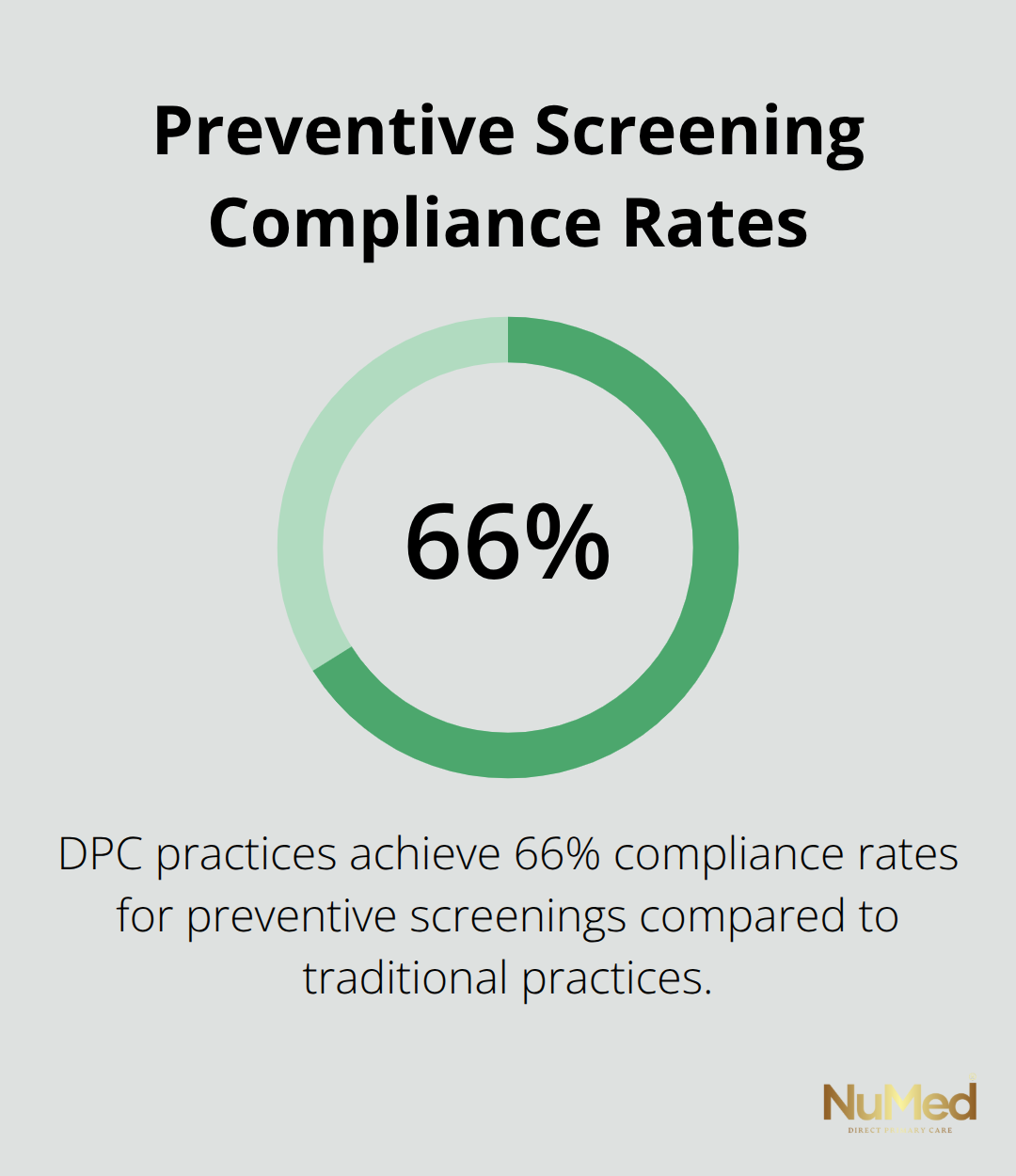Healthcare costs continue rising while patient satisfaction drops in traditional medical systems. Many Americans spend hours in waiting rooms only to receive rushed appointments that barely address their concerns.
Direct primary care explained simply: it’s a membership-based healthcare model that eliminates insurance middlemen and creates direct relationships between doctors and patients. We at NuMed DPC believe this approach transforms how medical care should work.
How Does Direct Primary Care Actually Work
Direct primary care operates on a simple monthly membership fee that patients pay directly to their doctor’s practice. The Direct Primary Care Coalition reports these fees typically range from $50 to $150 per month. This flat fee covers unlimited office visits, basic lab work, preventive care, and direct communication with your physician through phone calls, texts, or emails.
Most DPC practices limit their patient panels to 300-600 patients compared to traditional practices that often manage 2,000-3,000 patients per doctor. This smaller patient load allows doctors to provide more personalized attention and comprehensive care.
The Insurance-Free Model
DPC practices function independently from insurance companies, which eliminates copays, deductibles, and prior authorizations entirely. Patients receive transparent prices for any additional services like specialty lab tests or procedures. This direct payment structure allows doctors to spend 30-60 minutes per appointment instead of the typical 7-12 minutes in traditional settings.
The American Academy of Family Physicians reports that DPC physicians have 40% lower burnout rates because they focus on patient care rather than insurance paperwork and administrative requirements.

Extended Access and Communication
DPC patients receive their doctor’s direct phone number and can typically schedule same-day or next-day appointments. Many practices offer 24/7 access for urgent questions through secure platforms or direct phone lines. This accessibility reduces emergency room visits by approximately 65% according to studies from the Direct Primary Care Journal.
Doctors in DPC practices coordinate care more effectively with specialists and provide comprehensive health coaching because they maintain smaller patient loads and longer appointment times (which creates stronger doctor-patient relationships).
These operational advantages set the foundation for understanding the significant benefits that DPC membership provides to patients and their families.
How DPC Membership Actually Works
Direct primary care membership operates through a straightforward monthly fee structure that replaces traditional insurance copays and deductibles. The Direct Primary Care Coalition data shows monthly fees range from $50-150 per adult, with family plans that typically cost $100-300 monthly. These fees provide unlimited office visits, basic lab work, minor procedures, and direct communication access to your physician through phone, text, or secure platforms.
Transparent Pricing Without Hidden Costs
DPC practices publish clear pricing for all services beyond the basic membership. Advanced lab tests cost $10-50, EKGs run $25-40, and minor procedures like skin tag removal cost $50-100. The Healthcare Financial Management Association reports DPC patients save an average of $2,000-5,000 annually compared to traditional insurance-based care because they avoid surprise bills, network restrictions, and administrative fees that insurance companies add to medical services.
Direct Access Without Insurance Barriers
DPC physicians maintain patient panels of 300-600 people instead of the typical 2,263 patients in traditional practices. This smaller patient load allows same-day appointments 90% of the time according to the American Academy of Family Physicians. Patients receive their doctor’s direct phone number and can schedule visits within 24-48 hours without referrals or prior authorizations (which eliminates weeks of wait times). The absence of insurance paperwork allows doctors to spend 30-60 minutes per appointment and focus entirely on patient care rather than administrative requirements.
Personalized Care Through Extended Relationships
DPC doctors track patient health trends over time because they maintain long-term relationships without insurance network changes that force patient transfers. Research shows DPC practices achieve improved preventive care compliance because doctors can provide comprehensive health coaching and follow-up care. Patients receive personalized treatment plans based on their specific health goals rather than standardized protocols that insurance reimbursement rules drive.
These membership benefits create the foundation for substantial cost savings and improved health outcomes that DPC patients experience compared to traditional healthcare models.
Why DPC Saves Money and Improves Your Health
Financial Transparency Eliminates Medical Surprises
DPC membership fees of $50-150 monthly replace unpredictable medical bills that average Americans face. The Healthcare Financial Management Association found DPC patients save $2,000-5,000 annually because they avoid insurance deductibles that now average $1,644 for individual plans and $3,392 for family coverage. Traditional healthcare patients pay copays that range from $25-50 per visit, plus additional costs for lab work and procedures that insurance partially covers. DPC practices publish fixed prices for everything: basic metabolic panels cost $15-25, thyroid tests run $20-35, and minor procedures like joint injections cost $75-150. This transparent approach allows families to budget healthcare expenses accurately instead of facing surprise bills that force 530,000 Americans into bankruptcy annually (according to the American Journal of Public Health).
Same-Day Access Prevents Small Problems from Becoming Expensive Emergencies
DPC practices schedule 90% of appointments within 24 hours compared to traditional primary care that averages 24-day wait times according to the Medical Group Management Association. This immediate access prevents minor health issues from escalating into costly emergency room visits that average $2,200 per visit. DPC doctors spend 30-60 minutes per appointment and conduct thorough examinations that catch health problems early, when treatment costs less and outcomes improve significantly. The Direct Primary Care Journal reports that DPC patients reduce specialist referrals by 40% because their primary care physicians have time to manage complex conditions comprehensively. Extended appointment times allow doctors to address multiple health concerns in a single visit rather than requiring separate appointments that multiply costs and time commitments for patients.
Preventive Care Focus Delivers Measurable Health Improvements
DPC physicians track patient health trends over the years because they maintain stable doctor-patient relationships without insurance network disruptions. Research published in the Journal of the American Board of Family Medicine shows DPC practices achieve 66% compliance rates for preventive screenings compared to traditional practices. This higher compliance translates into earlier detection of chronic diseases like diabetes and hypertension that cost Americans $327 billion annually when diagnosed late (which represents a massive financial burden on the healthcare system). DPC doctors provide comprehensive health coaching that helps patients lose weight, quit smoking, and manage chronic conditions through lifestyle modifications rather than expensive medications alone.

Final Thoughts
Direct primary care, explained through real-world results, shows a healthcare model that prioritizes patient relationships over insurance bureaucracy. DPC practices deliver measurable advantages: $2,000-5,000 annual savings, 90% same-day appointment availability, and 66% preventive care compliance rates compared to traditional medicine’s lengthy wait times and surprise bills. The Direct Primary Care Coalition reports membership growth of 300% since 2017, with over 1,200 practices now operating nationwide (reflecting patient demand for transparent pricing and direct physician access).

This expansion demonstrates how patients seek predictable healthcare costs and extended appointment times that traditional insurance-based models cannot provide. DPC works particularly well for families who want transparent healthcare expenses, individuals with chronic conditions who need ongoing management, and anyone frustrated with rushed appointments and administrative barriers. The model’s focus on preventive care and early intervention reduces long-term healthcare expenses while improving health outcomes through personalized treatment approaches.
We at NuMed DPC combine this proven direct primary care model with functional medicine and comprehensive health coaching to address root causes of illness. Our compassionate healthcare approach delivers the personalized attention and transparent pricing that transform how medical care works for you and your family. This direct relationship between doctor and patient creates the foundation for better health outcomes and predictable healthcare costs.
















